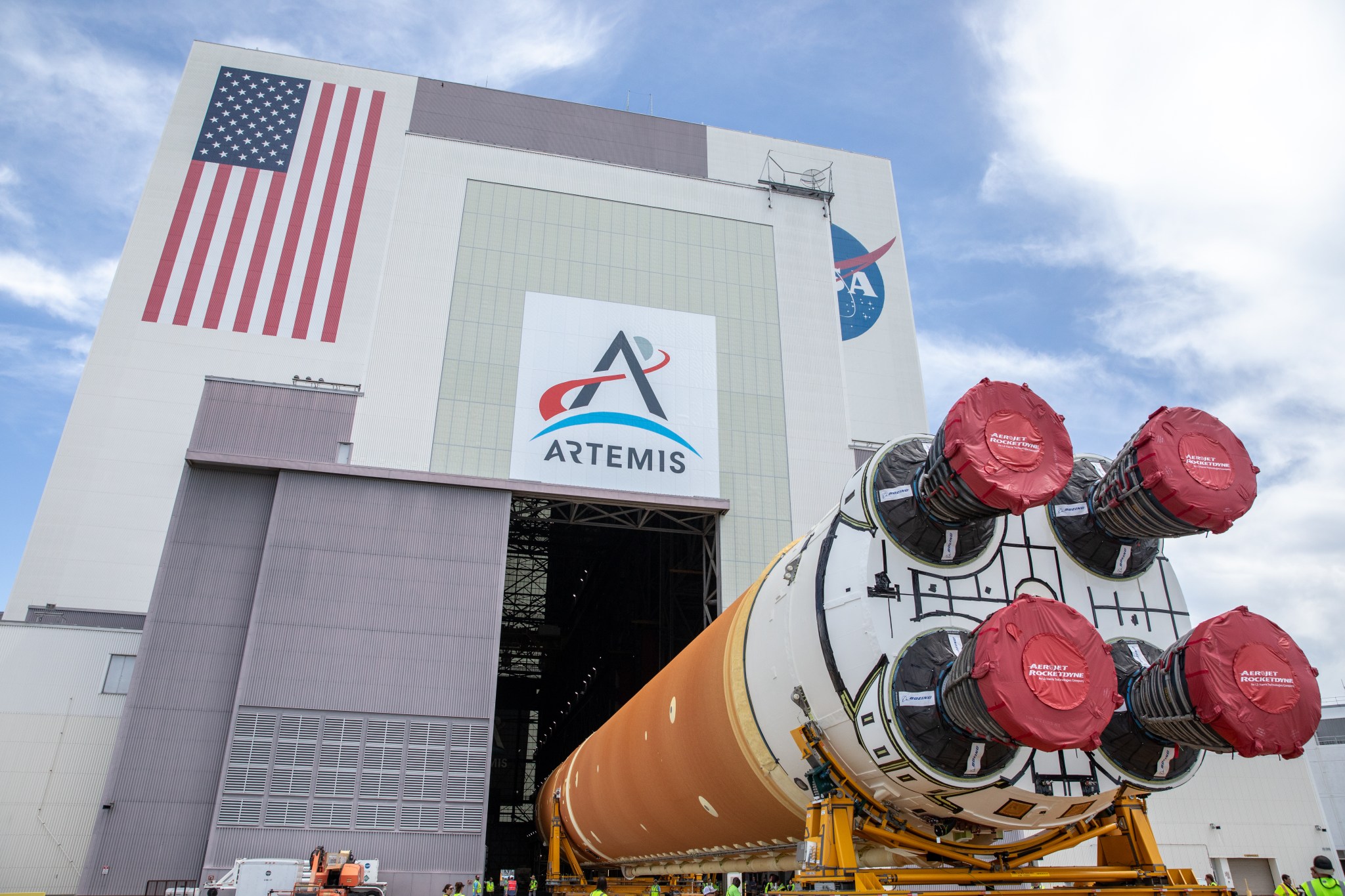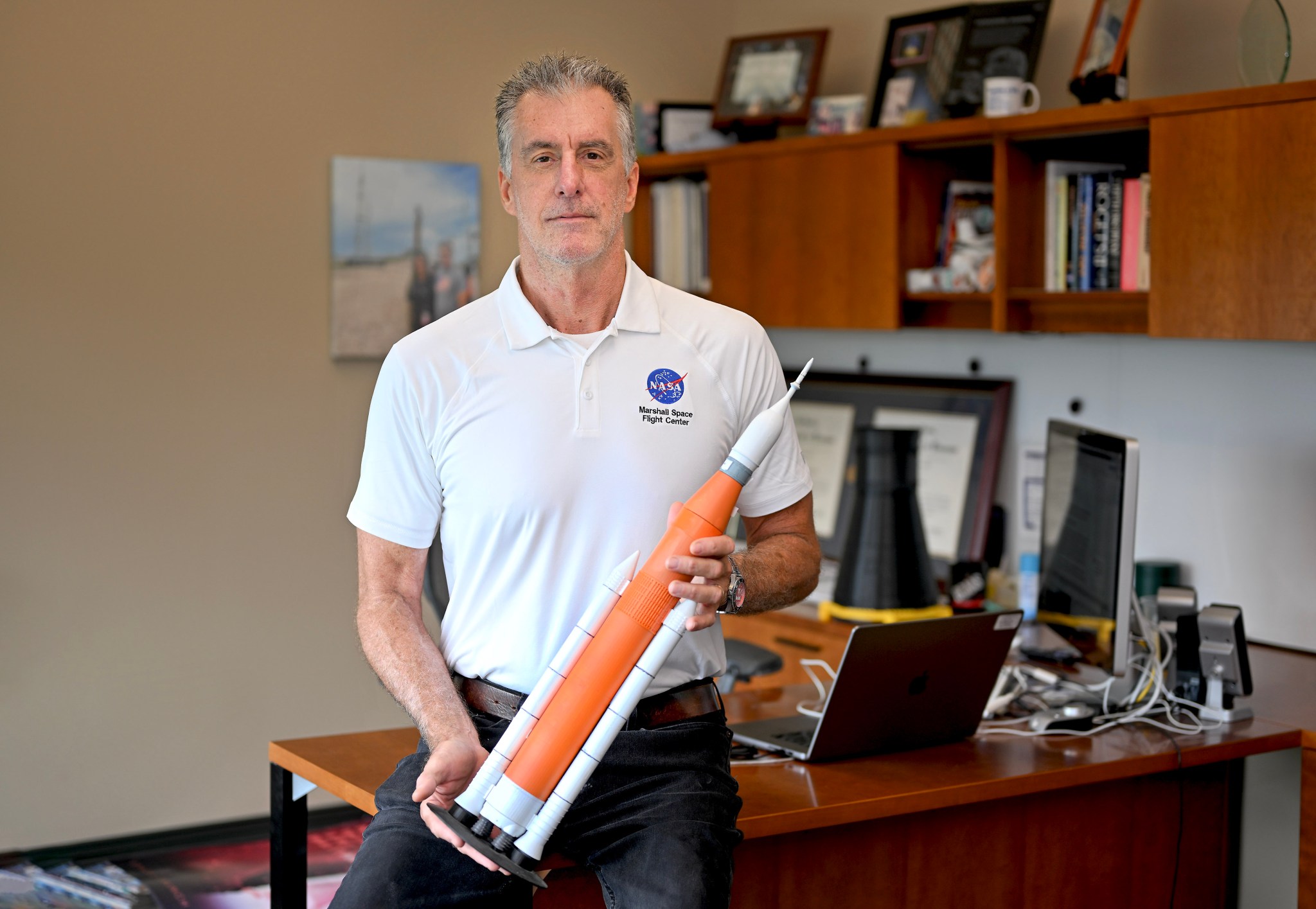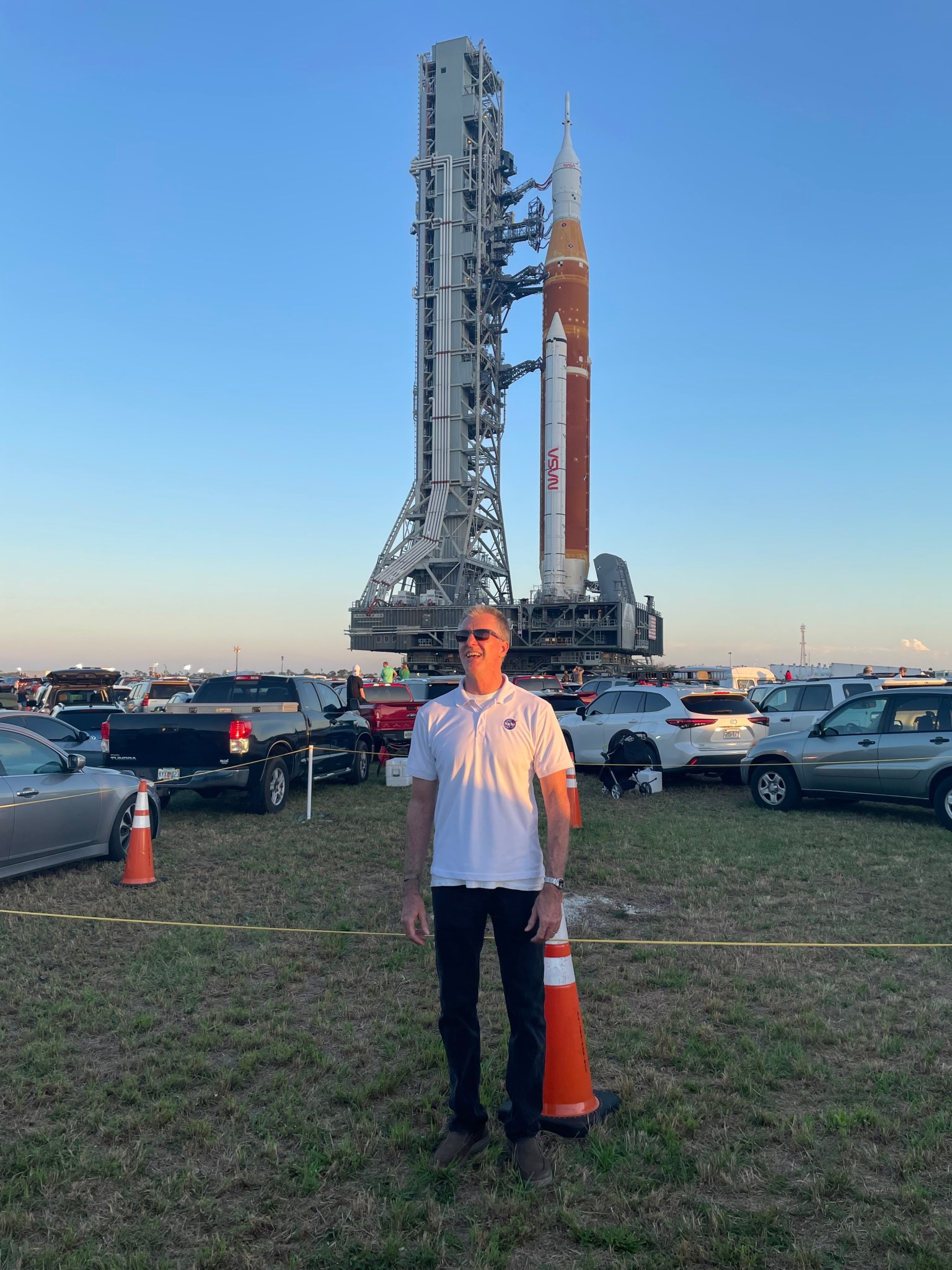
SLS Core Stage Rolls Inside Vehicle Assembly Building at Kennedy
NASA's SLS (Space Launch System) rocket core stage for the Artemis II mission is inside the Vehicle Assembly Building at the agency's Kennedy Space Center.
Tugboats and towing vessels moved the barge and core stage 900-miles to the Florida spaceport from NASA's Michoud Assembly Facility, where it was manufactured and assembled.

Team members with NASA's Exploration Ground Systems Program safely transferred the 212-foot-tall core stage from the agency's Pegasus barge, which arrived at NASA Kennedy's Complex 39 turn basin wharf on July 23, onto the self-propelled module transporter, which is used to move large elements of hardware. It was then rolled to the Vehicle Assembly Building transfer aisle where teams will process it until it is ready for rocket stacking operations.
In the coming months, teams will integrate the rocket core stage atop the mobile launcher with the additional Artemis II flight hardware, including the twin solid rocket boosters, launch vehicle stage adapter, and the Orion spacecraft.
The Artemis II test flight will be NASA's first mission with crew under the Artemis campaign, sending NASA astronauts Victor Glover, Christina Koch, and Reid Wiseman, as well as CSA (Canadian Space Agency) astronaut Jeremy Hansen, on a 10-day journey around the Moon and back.
Take 5 with Chris Calfee
By Wayne Smith
Ask Chris Calfee about his favorite memory from his 38-year career at NASA's Marshall Space Flight Center and you'll discover it's a difficult question to answer.
That's because there have been many memories.

Calfee was the integrator for the upper stage spacecraft for the Marshall-led Chandra X-Ray Observatory, which marked its 25th launch anniversary July 23. He's worked with Demonstration of Autonomous Rendezvous Technology (DART), a technology mission aimed at demonstrating that a spacecraft could independently rendezvous with an orbiting satellite without human intervention. Calfee was the booster manager for the Ares I-X test flight, which he points to as another career highlight.
And then there's his favorite memory - working with NASA's SLS (Space Launch System) rocket and watching the 2022 Artemis I launch from NASA's Kennedy Space Center.
"I've been fortunate in my career to have the opportunities I've had with NASA," said Calfee, the SLS Spacecraft Payload Integration and Evolution (SPIE) element manager. "Seeing the Chandra mission fly and the success it has had is awesome. Being able to work DART from cradle to grave, including its flight, was unforgettable. But I'd have to say being able to represent the SLS SPIE Element Office at Kennedy's Launch Control Center and seeing Artemis I light up the night sky is the proudest moment."
As the SLS Spacecraft/Payload Integration and Evolution element manager, Calfee's responsibilities include overseeing the development and delivering key adapter hardware for SLS rockets that will power the first crewed Artemis missions and first flight of SLS in its evolved Block 1B configuration. The hardware includes the launch vehicle stage adapter, interim cryogenic propulsion stage, and the Orion stage adapter - and the universal stage adapter for SLS Block 1B. The SPIE Element Office serves a key role in the successful execution of the SLS mission, both for the initial launch capability as well as the evolution of subsequent rocket configurations.
NASA moved a step closer to the Artemis II launch with the July shipment of the SLS core stage to Kennedy from the agency's Michoud Assembly Facility. Calfee and his team have the adapters complete for Artemis II and will soon ship them to Kennedy for launch preparations. As work advances toward Artemis II, Calfee looks back on the Artemis I launch as a "surreal experience." But he put his celebration on hold as he watched the initial moments of the flight.
"The pressure was on the SPIE hardware to finish the job for SLS as we tracked the successful booster burn and separation, and then the core stage's excellent performance," said Calfee, who is from Newport, Tennessee, and a graduate of the University of Tennessee. "The interim cryogenic propulsion (ICPS) stage 20-minute burn was approximately one and a half hours after launch, followed by Orion spacecraft separation from the ICPS and Orion stage adapter, the most critical event of the mission from my perspective. It was another huge relief to see the ICPS burn and the Orion separation event go flawlessly."

Memorable indeed.
Question: Looking ahead to Artemis II and the Artemis campaign, what excites you most about the future of human space exploration and your team's role it?
Calfee: For me personally, it is exciting just to be a part of the future of human space flight and having the opportunity to influence that future. With respect to the SPIE team, it's a similar feeling. Having the opportunity to lead a team that has such a significant role and responsibility in our future is an awesome experience.
Question: Who or what drives/motivates you?
Calfee: The opportunity to make a difference, be a part of history, and lead and mentor our future leaders.
Question: Who or what inspired you to pursue an education/career that led you to NASA and Marshall?
Calfee: My parents were my inspiration and provided me the opportunity to pursue my education. Although I followed the space program as a kid, specifically the Apollo program and Moon landings, I never dreamed that I would actually have the opportunity to work for NASA. I found my way to NASA via an on-campus interview job fair, was invited to Marshall for a follow-up interview, and it became an easy decision when an offer was made.
Question: What advice do you have for employees early in their NASA career or those in new leadership roles?
Calfee: For those early in their career, keep an open mind and be willing to take on new challenges. Diversify the resume. For those in new leadership roles, never get complacent. The moment you think you have it all figured out, something will surprise and humble you. I love the quote, "Get comfortable being uncomfortable," because I guarantee as a leader, you will experience many uncomfortable moments.
Question: What do you enjoy doing with your time while away from work?
Calfee: Spending time with my grandkids. I also enjoy homebrewing and wine making, and I probably spend too much time following and watching college sports.
Smith, a Media Fusion employee and the Marshall Star editor, supports the Marshall Office of Communications.






